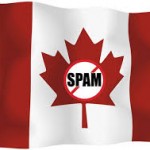New legislation was passed in Canada to try to reduce the amount of email spam across the country. This sounds like good news all around for a cleaner inbox, but what about that email marketing campaign you were about to kick off? Read our guest blog post to learn about Canada’s Anti-Spam Legislation and make sure your emails are getting where they need to go.
The first portion of the Canadian Anti-Spam Law (S.C. 2010, c. 23) came into effect July 1, 2014 and the second portion which includes the application of fines comes into effect on July 1, 2017. If you are in Canada or send mail to Canada, you need to know about this law. Since the law has come into force now, here are the steps you need to take:
- 1. Stop sending commercial messages to those you have not contacted before
Unless you have implied consent (which is obtained via a prior contact / purchase / enquiry); you no longer have the right to send a commercial message to these individuals / companies.
Commercial messages (CEMs) are defined by asking:
“Is one of the purposes to encourage the recipient to participate in commercial activity?
When determining whether a purpose is to encourage participation in commercial activity, some parts of the message to look at are:
- the content of the message
- any hyperlinks in the message to website content or a database, and
- contact information in the message.”
On the opposite side of the equation are ‘transactional’ e-mails; e-mails that are sent as a follow-up on an order that was placed to update on tracking information, availability, etc. or as a direct response to an enquiry. These e-mails are not considered a CEM and as such, are exempt from the laws that govern their use.
- 2. Ensure your commercial messages are up to standard
If you are sending a CEM, you need to comply with three requirements. You need to:
(1) obtain consent,
(2) provide identification information, and
(3) provide an unsubscribe mechanism.
Very straight-forward and if you have been compliant with CAN-SPAM in the US, you would be compliant with the standards. One major area of concern though is consent.
- 3. Obtain Consent
You want to, as much as possible, get express consent. Express consent requires you to inform the customer that you will be contacting them, a brief summary of the contents of the messages and finally, the consent must be requested as a separate feature. For example, you cannot make it a requirement that customers receive e-mails and purchase from you, they must be able to opt-in to receiving e-mails and must be able to complete their purchase without opting-in to receive e-mail messages.
Of particular note when requesting consent, and a difference from CAN-SPAM, you must gain express consent via an opt-in. Pre-checked boxes / opt-out clauses are not allowed.
- 4. Keep Records
Most importantly, you want to keep records of the consent that you have obtained. This means ensuring you keep server logs of the subscription and any confirmation of subscription (if you do double opt-in).
For implied consent, you will want to keep logs of the purchase (order confirmation e-mails, database of the purchase, etc.) in the last 2 years and any enquiries you have received in the last 6 months. By 2017 when the last part of the act comes into force, you could be fined for up to $1 million per infraction if you do not have these logs.
- 5. Do Your Best
Finally, read up the act yourself and do your best to comply. The CRTC has said that “We are not going to go after every indie rock band that’s trying to sell a new release to its fans. We have much bigger fish to fry.”
BIO: This article is contributed by Fortress Geek, a Canadian E-Commerce Business selling Geek Products in Canada.
Share your thoughts with us on Facebook, Twitter, and Google+.


